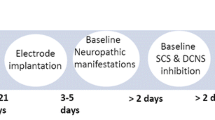Summary
In 54 cats electrical stimulation of the periaqueductal grey matter was performed by electrodes which were placed in distinct regions of the aqueduct. The influence on pain was studied by the formalin test. Motor behaviour was observed. The results show an obvious inhibition of pain reactions, which was most effective in the upper of the aqueduct. The motor functions were disturbed only in some cats with lesions of the cerebellar vermis. The advantage of this method is that it is not necessary to place the stimulating electrode into the midbrain tissue. This procedure might be appropriate for patients with severe chronic pain in face and body, in whom other surgical methods have failed.
Zusammenfassung
Bei 54 Katzen wurden Reizungen des zentralen Höhlengraus über Elektroden vorgenommen, die in verschiedenen Regionen des Aquädukts lagen. Es wurde der Einfluß der Stimulation auf Schmerzreaktionen untersucht, die durch den Formalintest ausgelöst wurden. Außerdem wurde das motorische Verhalten beobachtet. Die Ergebnisse zeigen eine deutliche Hemmung der Schmerzreaktionen, vor allem bei Reizungen im oberen Aquädukt. Motorische Störungen fanden sich lediglich bei einigen Katzen, bei denen es zu einer Schädigung des Kleinhirnwurms gekommen war. Der Vorteil der Methode ist, daß die Elektrode ohne Läsion von Gewebe des Mittelhirns in den Bereich des zentralen Höhlengraus plaziert werden kann. Eine Anwendung dieser Methode ergibt sich bei Patienten, die unter chronischen, schweren Schmerzzuständen des Gesichtes oder des übrigen Körpers klagen und bei denen andere operative Eingriffe versagt haben.
Similar content being viewed by others
Literaturverzeichnis
Basbaum AJ, Marley N, O'Keefe J (1976) Spinal cord pathways involved in the production of analgesia by brain stimulation. In: Bonica JJ, Albe-Fessard D (eds) Advances in pain research and therapy. Raven Press, New York 1, pp 511–515
Drake CG, McKenzie KG (1953) Mesencepahlic tractotomy for pain. J Neurosurg 10:457–472
Dubuisson D, Dennis StG (1977) The formalin-test a quantitative study of the analgesic effects of morphine, meperidine, and brain stem stimulation in rats and cats. Pain 4:161–174
Fields HL, Anderson SD (1978) Evidence that raphe-spinal neurons mediate opiate and midbrain stimulation-produced analgesias. Pain 5:333–349
Goodman SJ, Holcombe V (1976) Selective and prolonged analgesia in monkey resulting from brain stimulation. In: Bonica JJ, Albe-Fessard D (eds) Advances in pain research and therapy. Raven Press, New York 1, pp 495–502
Gybels J, Dom R, Cosyns P (1980) Electrical stimulation of the central gray for pain relief in human: autopsy data. Acta Neurochir [Suppl] 30:259–268
Hosobuchi Y (1980) The current status of analgesic brain stimulation. Acta Neurochir [Suppl] 30:219–227
Liebeskind JC, Guilbaud G, Besson JM, Oliveras JL (1973) Analgesia from electrical stimulation of the periaqueductal gray matter in the cat: behavioral observations and inhibitory effects on spinal cord interneurons. Brain Res 50:441–446
Liebeskind JC, Mayer DJ, Akil H (1974) Central mechanisms of pain inhibition. Studies of analgesia from focal brain stimulation. Adv Neurol 4:261–268
Mayer DJ, Wolfle TL, Akil H, Carder B, Liebeskind JC (1971) Analgesia from electrical stimulation in the brain stem of the rat. Science 174:1351–1354
Melzack R, Melinkoff DF (1974) Analgesia produced by brain stimulation: evidence of a prolonged onset period. Exp Neurol 43:369–374
Melzack R, Stotler WA, Livingston WK (1958) Effects of discrete brainstem lesions in cats on perception of noxious stimulation. J Neurophysiol 21:353–367
Melzack R, Wall PD (1965) Pain mechanism: a new theory. Science 150:971–979
Nashold BS, Wilson WP, Slaughter G (1974) The midbrain and pain. Adv Neurol 4:191–196
Oliveras JL, Besson JM, Guilbaud G, Liebeskind JC (1974) Behavioral and electrophysiological evidence of pain inhibition from midbrain stimulation in the cat. Exp Brain Res 20:32–44
Orthner H, Roeder F (1966) Further clinical and anatomical experiences with stereotactics operations for relief of pain. Confin Neurol 27:418–430
Reinonso-Suarez F (1961) Topographischer Hirnatlas der Katze. Merck, Darmstadt, FRG
Reynolds DV (169) Surgery in the rat during electrical analgesia induced by focal brain stimulation. Science 164:444–445
Rhodes DL, Liebeskind JC (1978) Lesions of the caudal periaqueductal gray reduce stimulation-produced analgesia from rostal brain stem sites. Second World Congress on Pain [Abstract 1]. IASP, Montreal 1978, p 310
Richardson DE, Akil H (1977) Pain reduction by electrical brain stimulation in man, part 1. Acute administration in periaqueductal and pericentricular sites. J Neurosurg 47:178–183
Richardson DE, Akil H (1977) Pain reduction by electrical brain stimulation in man, part 2. Chronic self-administration in the periventricular gray matter. J Neurosurg 47:184–194
Riechert T (1960) Die chirurgische Behandlung der zentralen Schmerzzustände, einschließlich der stereotaktischen Operationen im Thalamus und Mesencephalon. Acta Neurochirur 8:136–152
Soper WY (1976) Effects of analgesic midbrain stimulation on reflex withdrawal and thermal escape in the rat. J Comp Physiol Psychol 90:91–101
Spiegel EA, Wycis HT (1949) Mesencephalothalamotomy for relief of pain. Pötzl-Festschrift. Wagner, Innsbruck, pp 437–440
Walker AE (1942) Relief of pain by mesencephalic tractotomy. Arch Neurol Psychiatry 48:865–883
Author information
Authors and Affiliations
Rights and permissions
About this article
Cite this article
Spring, A. Der Einfluß des zentralen Höhlengraus der Katze auf Schmerz bei Elektrostimulation im Aquädukt. Res. Exp. Med. 184, 17–28 (1984). https://doi.org/10.1007/BF01852218
Received:
Accepted:
Issue Date:
DOI: https://doi.org/10.1007/BF01852218



